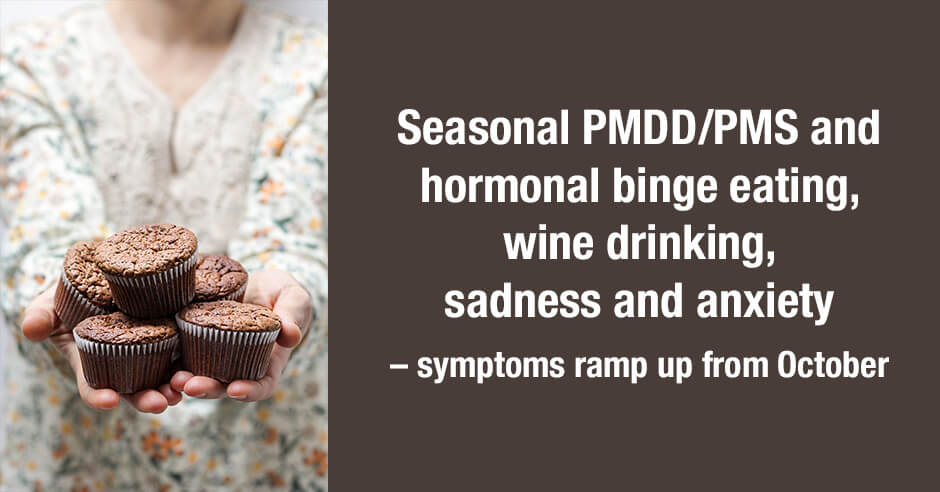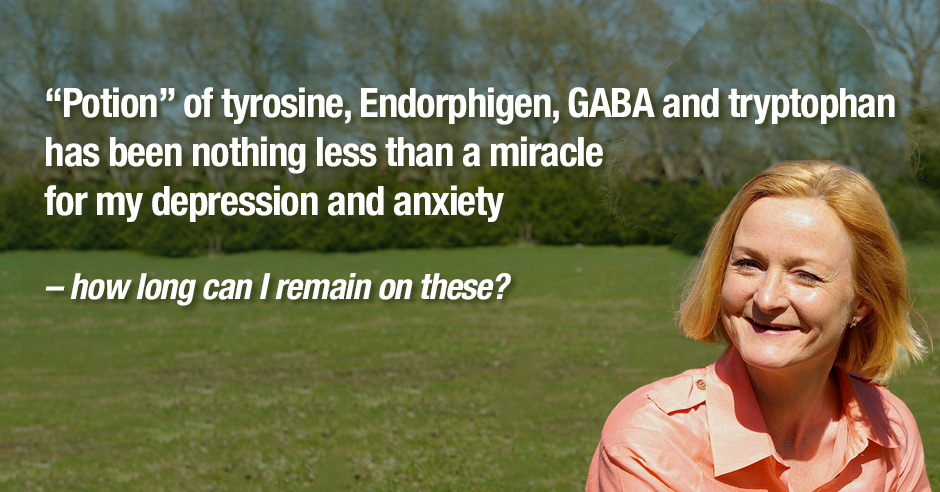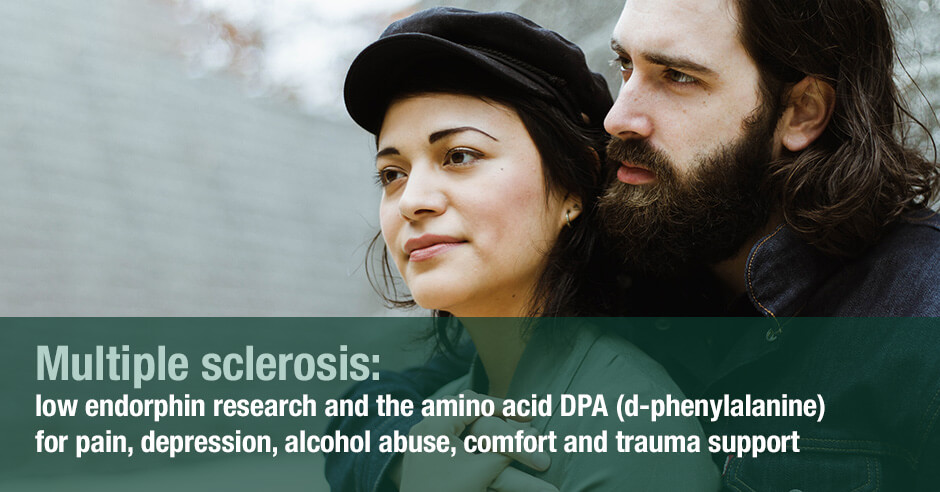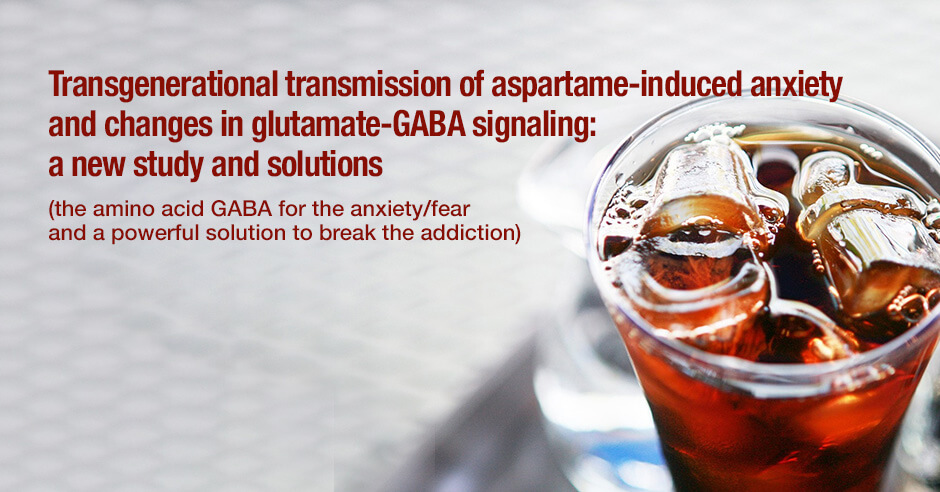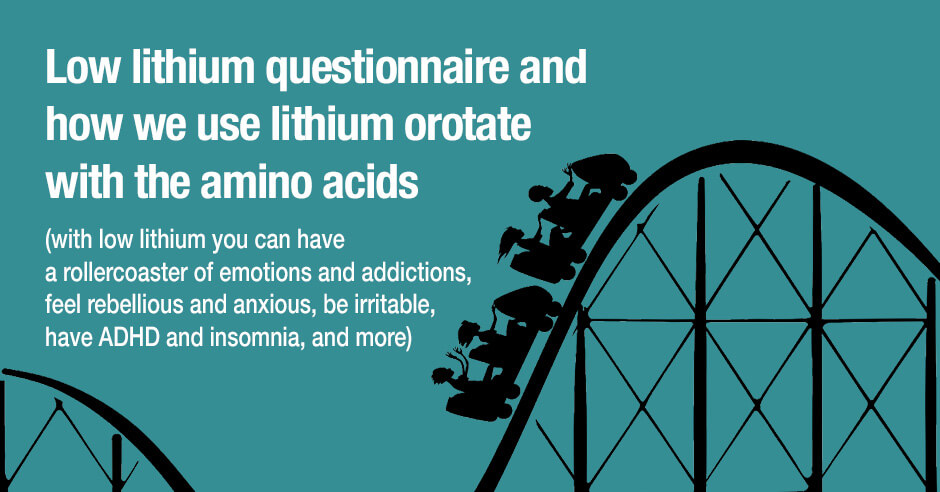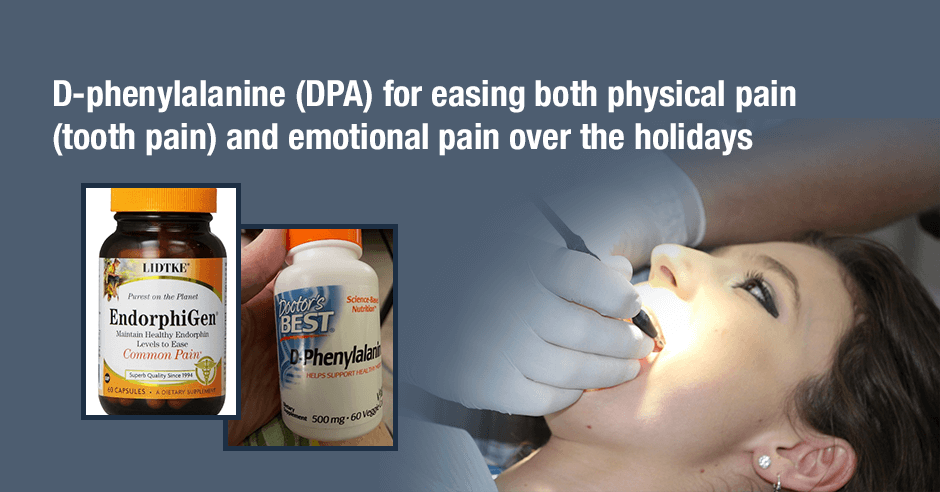
Today I share how the amino acid D-phenylalanine (DPA), used as a supplement multiple times a day, and opened on to my tongue, eased both the physical tooth pain I experienced for 14 days and the emotional pain I was feeling over the holidays.
In this blog I share more about DPA and endorphins when it comes to pain – both physical and emotional. I also share two DPA products I recommend, product label confusion and more about how DPA differs from DLPA (DL-phenylalanine). I am often asked this question and even long time users of DLPA are sometimes surprised to learn how different DPA is. As always, I like to share some research and other related blogs on the topic. Here is my recent and very positive personal experience with DPA, a firm favorite of mine:
I’m just back from the dentist – my crown was re-cemented and I’m a happy camper now. It popped off just before Christmas and I had to wait until now! There was a tiny cavity beneath the crown which is why I was having daily pain.
Thank goodness I always have DPA (the amino acid d-phenylananine) on hand. I gravitate to it for pain relief – sports injuries like muscle sprains, the rare headache and this time for tooth/jaw pain.
I opened a DPA onto my tongue as soon as I could feel the dull ache start and the pain relief lasted a few hours. It works by boosting endorphins to provide pain relief – kind of like acupuncture. I call it “powdered acupuncture”.
Some days I used 3-4 and one day I needed 6. Taking one before bed was wonderful.
I also got bonus benefits for emotional well-being over the holidays. It’s the first Christmas without my darling mom and I really needed the endorphin boost to help with the emotional pain.
The DPA product I used was Doctor’s best (details below) and I opened up the 500 mg capsule onto my tongue each time I needed pain relief.
The number of capsules I needed seemed to vary by how much chewing I was doing (for example, I had more pain after a steak meal vs smoked salmon) and what I was eating or drinking (for example, I had more pain after drinking something cold). I simply used a DPA capsule when the dull pain started, making sure it was away from protein (not always but most of the time).
One of the DPA products I recommend: Doctor’s Best D-Phenylalanine
There are not many d-phenylalanine/DPA products available but of those I have two that I recommend: Doctor’s Best D-Phenylalanine and Lidtke Endorphigen. Both contain 500 mg DPA but the labels can be confusing at first – at least until you’re familiar with them.
Also, this amino acid, DPA, is not to be confused with docosapentaenoic acid (also abbreviated as DPA), an omega-3 fatty acid similar to eicosapentaenoic acid (EPA).
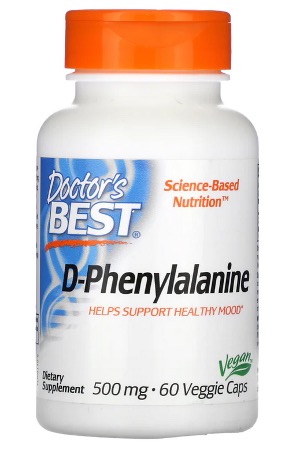
Here is the Doctor’s Best D-Phenylalanine description:
Doctor’s Best D-phenylalanine is a non-protein amino acid that acts as an inhibiting agent to enzymes that degrade enkephalins, naturally occurring peptides in the body that metabolize endorphins. Endorphins are neurotransmitters that play a key role in the function of the nervous system and are associated with feelings of pleasure. By limiting production of enzymes that break down endorphins, the supplement can help support a healthy mood and normal functioning of the nervous system.
- Helps support healthy mood
- Helps support endorphin metabolism
- Help support neurotransmitter function
This is the actual product that I used over the past 2 weeks and have used it on and off as needed for a few years. It was one of the nutrients that helped when I sprained my ankle when visiting my brother in Las Vegas. More here
As you can see there is no mention of pain on the label or product description. I share more on the pain/endorphin connection below.
You can purchase this online from their website or from iherb. If you use my iherb link you’ll save 5%. This is a good option if you’re not in the USA and already use iherb for one-stop shopping of quality products.
The other DPA product I recommend: Lidtke Endorphigen
The other product I recommend is Lidtke Endorphigen which also contains 500 mg DPA and a small amount of vitamin B6 and riboflavin (vitamin B2). As you can see, this product does mention pain but not the emotional support/mood benefits on the front label.
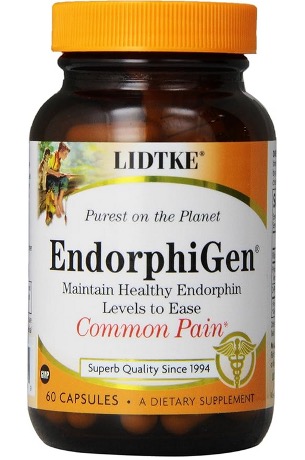
Here is the Lidtke Endorphigen description
Ease Minor Pain & Feel Good with Healthy Endorphin Level Maintenance
Endorphins are nature’s way to relieve common minor pain and promote a cheerful mood. Research shows that endorphins are released in response to pain and stress, bringing relief. The second wind and runner’s high during and after a vigorous run are results of endorphins. Acting as an analgesic and sedative, endorphins diminish our perception of pain…. But there is more.
Recovery centers report that endorphins promote recovery from a wide variety of unhealthy cravings.
Low endorphin symptoms and typical dosing of DPA
I use the symptoms questionnaire to help clients identify if they have low endorphin symptoms (you can see that here).
Typical dosing is 500 mg to 1000 mg DPA 3-4 x day between meals/away from protein. I do find having clients open the capsule onto their tongue to be more effective for quick pain relief – with results as quickly as 5-10 minutes.
DPA vs DLPA: they are quite different but have some overlaps
I am often asked if DPA and DLPA are the same – they are quite different but have some overlaps as outlined in this blog post on the topic: What is the difference between DPA and DLPA (amino acids) and which one do I use for weepiness, heart-ache, pain and energy?
The precautions are also not the same so I always review contraindications with all my clients and encourage you to do the same.
DPA for MS pain, weepiness, emotional pain and more
Here are a few blog posts illustrating the use of DPA in multiple sclerosis, weepiness, physical pain, emotional pain and resilience, cravings/emotional eating and even helping to wean off prescription pain medication:
- Multiple sclerosis: low endorphin research and the amino acid DPA (d-phenylalanine) for pain, depression, comfort and trauma support “The endogenous opioid system is …well known to play a role in the development of chronic pain and negative affect [i.e. depression], both of which are common comorbidities in MS.”
- DPA for weepiness, pain and comfort and reward eating
- The individual amino acids glutamine, GABA, tryptophan (or 5-HTP), DPA and tyrosine are powerful for eliminating sugar cravings, often within 5 minutes
- When using the amino acid DPA (d-phenylalanine) I have more resilience and more buffer in the caregiving work I do, and just the oops’s of life As I mentioned above, using DPA over these holidays also gave me more resilience and the endorphin boost I needed help with the emotional pain of losing my mom.
- Wean off prescription pain medication, improve sleep and reduce emotional eating with DPA (an endorphin-boosting amino acid)
Be sure to use the search feature on the blog to find additional applications of DPA.
DPA research on pain and depression
The use of DPA is not new as you can read in this paper from 1982 – D-phenylalanine and other enkephalinase inhibitors as pharmacological agents: implications for some important therapeutic application
A number of compounds have been shown to inhibit the degradation of enkephalins. As expected, these compounds produce naloxone reversible analgesia and potentiate the analgesia produced by enkephalins and by acupuncture.
One of these, D-phenylalanine, is also anti-inflammatory.
D-phenylalanine has proven to be beneficial in many human patients with chronic, intractable pain. It is proposed the enkephalinase inhibitors may be effective in a number of human “endorphin deficiency diseases” such as depression, schizophrenia, convulsive disorders and arthritis.
Additional resources when you are new to using DPA and the other amino acids as supplements
We use the symptoms questionnaire to figure out if low endorphins or other neurotransmitter imbalances may be an issue for you.
If you suspect low levels of any of the neurotransmitters and do not yet have my book, The Antianxiety Food Solution – How the Foods You Eat Can Help You Calm Your Anxious Mind, Improve Your Mood, and End Cravings, I highly recommend getting it and reading it before jumping in and using amino acids on your own so you are knowledgeable. And be sure to share it with the practitioner/health team you or your loved one is working with.
There is an entire chapter on the amino acids and they are discussed throughout the book in the sections on gut health, gluten, blood sugar control, sugar cravings, anxiety and mood issues.
The book doesn’t include product names (per the publisher’s request) so this blog, The Antianxiety Food Solution Amino Acid and Pyroluria Supplements, lists the amino acids that I use with my individual clients and those in my group programs. You can find them all – including the Lidtke Endorphigen 500 mg that I mentioned above.
Also mentioned above is Doctor’s Best D-Phenylalanine which can be purchased on iherb.
If, after reading this blog and my book, you don’t feel comfortable figuring things out on your own (i.e. doing the symptoms questionnaire and respective amino acids trials), a good place to get help is the GABA QuickStart Program (if you have low GABA symptoms too). This is a paid online/virtual group program where you get my guidance and community support.
If you are a practitioner, join us in The Balancing Neurotransmitters: the Fundamentals program. This is also a paid online/virtual program with an opportunity to interact with me and other practitioners who are also using the amino acids.
Have you had success using DPA for your pain issues – what kind of pain has it helped and how much has helped you?
Has DPA also helped with emotional pain and weepiness? And cravings/emotional eating?
If you’re a practitioner do you have success using DPA with your clients/patients?
Feel free to share and ask your questions below.
